Avoiding Asynchronous eLearning

One of the problems that every elearning solution or staff training system needs to address is the fact that companies need to retrain their employees after a certain period of time.
This mainly occurs due to a well-known memory-dilemma defined as the Ebbinghaus forgetting curve.
Firstly, neurological research conducted on learning activities showed that absorbing a lot of information in one go is nearly impossible for the majority of people. This means that extremely long sessions that cover a lot of material don’t usually represent a very effective learning experience.
We all experience that after attending a conference or a long seminar. In the end, unless we go back to the slides and our own notes, we tend to remember just a few details that really stood out because they proved to be surprising or extremely relevant. We tend to remember those concepts that are either unexpected or particularly linked to our daily experience and that seem to address actual concerns we expressed at some point.
The remaining content of the presentations remains blurred and just represents context or noise.
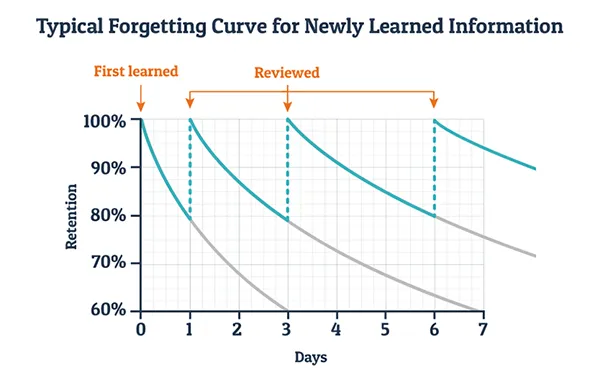
Table of Contents
Key Mechanisms Connected to the Forgetting Curve
This proves that people tend to remember just a portion of what they learn in a single session. You might have experienced this yourself: you’re at university and you realize that you’re way behind schedule while preparing for an exam. What happened then is that you went through the entire course material in just a few days before the exam. Even if you managed to pass the test, chances are that you eventually forgot most of what you learned just after a few days after the exam.
We need time to take in and process information, work with it, look at it from different angles and perspectives, and make it our own by associating the newly acquired knowledge to everyday problems.
When planning macro-learning activities, it is important to take into account the amount of information that needs to be provided in each session.
Additionally, though, the forgetting curve is also connected to other mechanisms which are deeply rooted in the concepts of relevance and habit.
Relevance
Our brain capacity is limited, and we’re very selective when it comes to deciding whether or not we want to permanently store a particular memory or piece of information.
You might try to learn everything there is to know about accounting regulations, but if you aren’t required to apply any of these norms in your daily life, then you won’t be able to remember much.
Relevance is deeply interwoven with needs. With so many inputs and stimuli reaching us, we only pay attention to those we rely upon for survival, success, and contingent necessity.
Say your company offers you an incredibly attractive package if you relocate you to France. Your intrinsic motivation will facilitate the process of learning French. As a matter of fact, your success depends on your ability to communicate important concepts using a new language. Your learning experience might go through ups and downs, but relevance and motivation will help you remember your vocabulary.

Contrast this situation with a student who’s forced to learn French in school but knows that they’ll probably never use it (or at least won’t see any advantage in the foreseeable future). The experience is a lot more painful and memorizing information will be mechanical and exhausting.
Before cell-phones were invented people had to memorize a bunch of important telephone numbers. With simple mnemonic tricks, this wasn’t hard at all. Learning a few phone numbers by heart is still not a tough task. However, since we don’t perceive the need, I bet we would all struggle to keep them in mind for a while. The task would be perceived as irrelevant and we’d probably shut down our brain cells after a few weeks and forget all the numbers we memorized.
Habit
Habit is another facilitator. We all know that repetition is what truly helps information to become permanent. People used to remember their own phone number also because they were used to repeating it to others in various social occasions.
Think of a pilot. They need to be constantly flying because of all the processes they need to keep in mind. Even if you love flying and you’re highly motivated, if you don’t fly on a regular basis, you’re bound to forget particular standard procedures.
And that leads to an insidious issue connected to the forgetting curve.
Even if we work in a particular field, there are always edge cases that only occur rarely. Going back to our pilot example, there are situations that pilots seldom need to deal with (and often dealt with just in a simulation). A CAT III approach, for instance, is a very difficult landing procedure that involves unreasonably low visibility due to terrible weather conditions. Pilots are trained on such approach in simulations, but they’ll probably have to deal with it just a few times in their entire career.

Such approach requires pilots to follow a long series of steps and standard operation procedures. Success (landing) is strictly connected to such procedures. Intrinsic motivation is high (your life literally depends on the information you learned) but, in some cases, pilots opt for a go around and look for an alternate airport to land. Their choice is smart and nobody will be blamed for it (all in all the only important thing is the safety of the passengers) but the situation is sub-optimal.
The lack of habit is a phenomenon that exacerbates the forgetting curve.
How to solve problems connected to the forgetting curve
Spaced Learning for eLearning Solutions
Massive injections of new knowledge are connected to a rapid memory decay. As mentioned above, this holds particularly true when too much information is absorbed in one single session.
The first step, then, is spacing out information at specific intervals to allow learners to process data and processes.
In standard spaced elearning processes, condensed content is spaced out in different sessions with breaks. Such concept is linked to temporal patterns of stimuli and the formation of long-term memories reported in studies conducted by R. Douglas Fields.
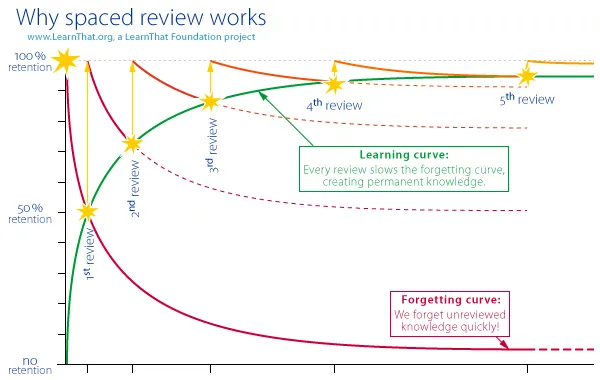
When onboarding new employees, we need them to be up to speed in the shortest time possible.
However, macro-learning processes need to follow specific patterns that facilitate the formation of competence. The same applies when training existing staff on new concepts, processes, or procedures.
Optimally, every macro-learning experience should allow space for distractors, meaning elements that aren’t related to the learning material that occupy the space in between learning sessions.
Spaced learning proved to be an extremely successful methodology to teach complex topics in a relatively short period of time.
Micro-Learning to Support Learners Over Time
Whereas macro-learning solutions are required to quickly assimilate new knowledge and skills, micro-learning solutions support learners over time and on demand.
Whenever help is needed, learners can access topics and context based informational material that allow them to accomplish a particular task.
Such information needs to be centralized, available on demand, searchable/indexed, and up to date.
Think of a lawyer who only needs to quickly check a particular case or a doctor who needs to review a specific protocol…
At work, we often face similar challenges and adopt a series of standard procedures. That’s the concept of habit explained above. But, once in a while, we have to perform extraordinary tasks we learned but don’t feel familiar with (go back to our example with a difficult landing approach).
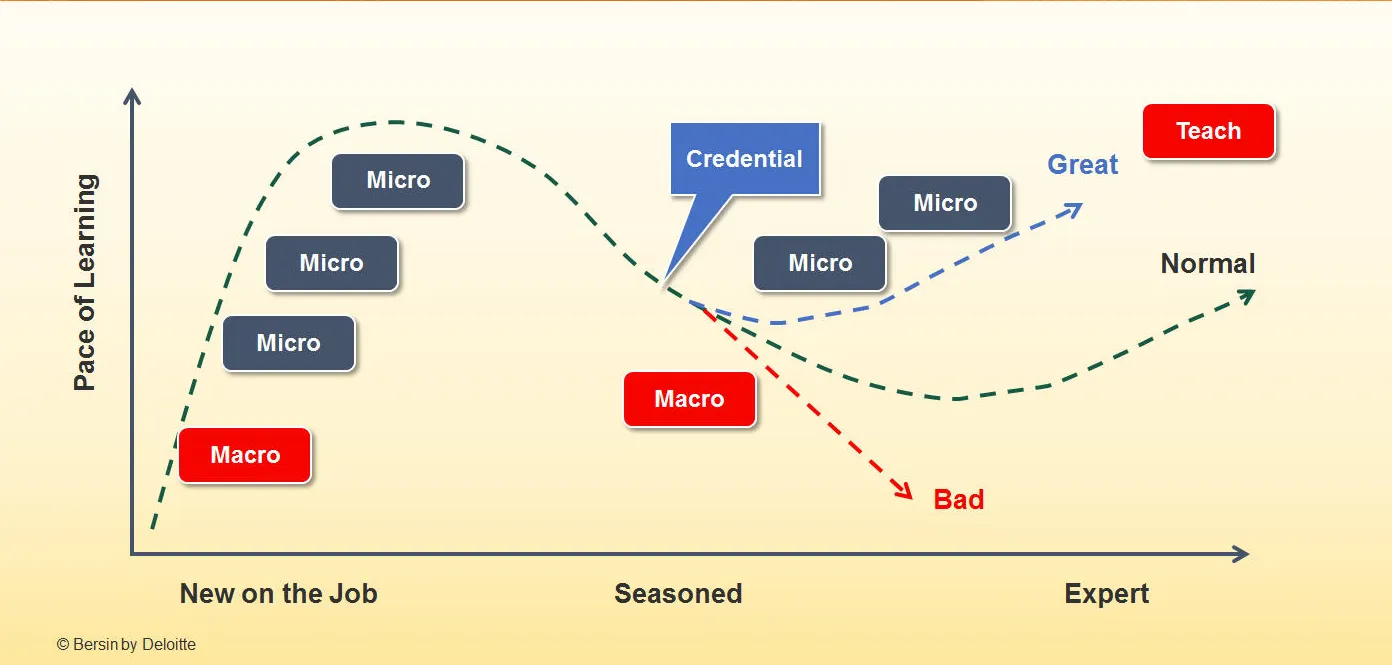
Micro-learning is becoming extremely useful as a form of support that offers an alternate solution to the problems connected to the forgetting curve.
eLearning solutions that also offer macro-learning experiences now incorporate tools that allow learners to easily find information on-demand and quickly go through processes to review concepts that might have been forgotten due to the absence of habit.
Micro-learning tools are also useful when it comes to repetition. A carefully organized and well spaced macro-learning experience might be followed by micro-learning sessions that reinforce the formation of long-term memories through repetition.
By being forced to retrieve stored information at regular intervals and in different situations, we create new learning pathways and the forgetting curve flattens out.
Replacing Asynchronous Activities with Practice
The fact that learn by doing is highly effective is well documented. Workshops that lead learners to actually accomplish tasks and achieve concrete results are proven to be viable learning experiences.
We tend to connect concepts to experiences. Practice is connected to results, and this facilitates the acquisition of new knowledge.
How much do you actually remember of what your professor told you at University compared to know-how and skills you acquired on the job?
Our brain is tough to deceive. Learning concepts and skills on paper is not as effective as being forced to adapt to a new situation in real life.
That’s why learning to speak a language by reading a book or doing exercises on your couch is nearly impossible. Contrast that to a person who moves to a new country and needs to negotiate with authorities, buy groceries, have a social life, and find a job. Every interaction is connected to a rapid improvement.

After all, you won’t run a marathon in less than four hours by watching videos of successful marathoners!
The example might seems extreme (we’re talking about a physical skill) and be closer to practical skills connected to surgery, or driving that require practice…but the same concept applies for nearly every area of competence. It’s irrational to think that a person can become a successful marketer by simply reading some text-books. A marketer becomes successful after a certain amount of time in which they deal with experiments, problems, and data.
Asynchronous learning occurs when we first need to absorb new information and then apply the know-how at a later stage.
Think of situations in which you’re first required to watch a video tutorial or read an instruction manual and then go back to work and follow the instructions you just received.
Chances are that you’ll have to go back and forth and keep watching the video or reading another paragraph in a text document to proceed step-by-step through a process.
This leads to two main problems:
On the one hand, the system is highly inefficient and frustrating. On the other hand, the experience will have little to no positive effect on the learning curve.
We become highly skillful at what we do when we’re followed in real time while we accomplish new tasks. Not surprisingly, mentorship programs are very effective. When we’re followed step-by-step by someone who guides our actions and decision making processes through a particular task in real time, we learn more efficiently and tend to store information for a longer time.
We connect the experience to a specific context and to actual results and, in this case, we’re quick at creating new learning pathways.
The Case for eLearning Solutions for Software Applications
Userlane is a navigation system for software.
Our product goes on top of any other browser-based software and guides users step-by-step and in real time while they actually accomplish tasks in the application they’re working on.
When staff needs to be onboarded or trained on a software solution, our on-screen, interactive tutorials work synchronously as both a macro and micro-learning solution.
We consciously developed our product with a “learn-by-doing” mentality that mitigates problems connected to the forgetting curve.
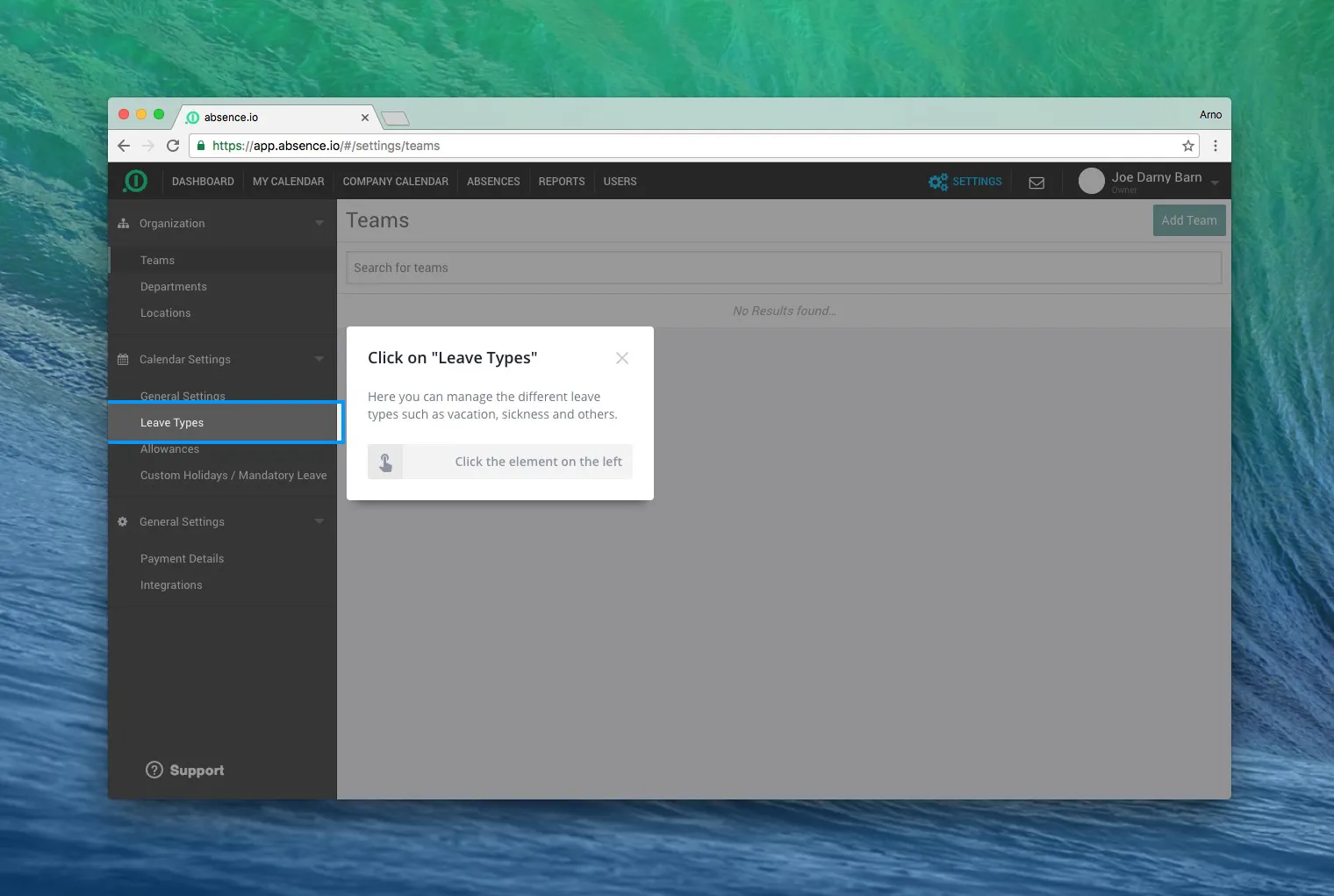
Our guides steer people through processes in real time. This means that learners don’t need to follow instructional videos, attend training courses, or read handbooks and then go back to their applications and carry out tasks.
People are guided step-by-step with on-screen contextual help and interactive software wizards that allow them to successfully perform any task in a completely new environment without any delay or disruption.
Userlane can be used as a macro-learning platform to simultaneously introduce new software to existing employees or onboard new staff members.
In this case, learners simply access the actual software application they need to work on, and a welcome slide prompts them to start the learning process.
Learners are presented with a series of mandatory guides they need to go through subdivided into chapters to reflect the software structure and the processes that need to be learned.
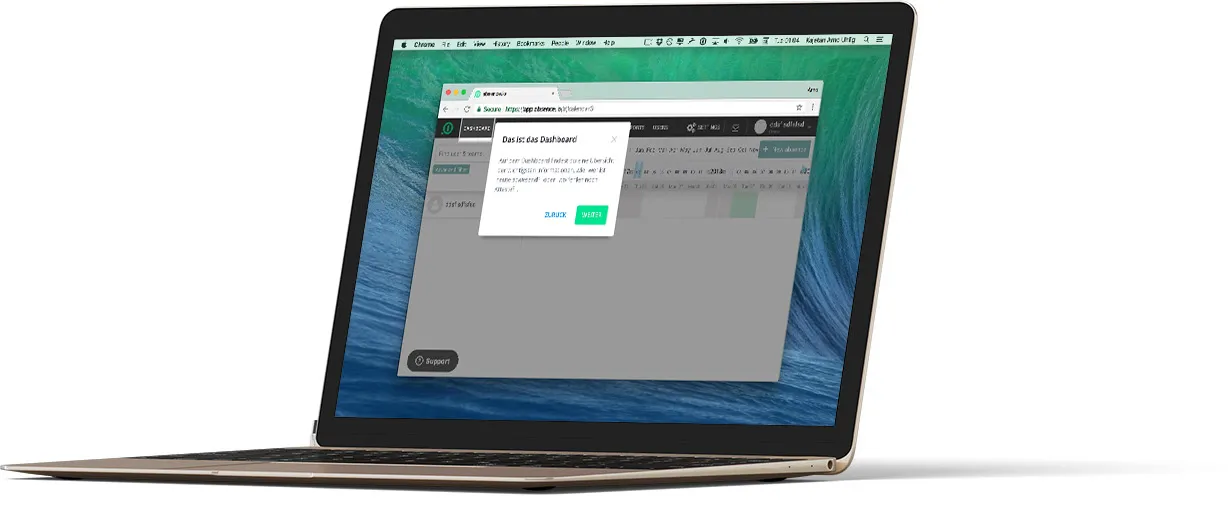
Each guide is locked and can be unlocked by completing a previous one. The process is intelligent, and gamified. Learners see their progress, receive immediate feedback, and are rewarded throughout the learning experience.
Analytics in the back end, show aggregate data regarding the rate at which learners go through guides, together with completion rate, and other important metrics that show the effectiveness of the process.
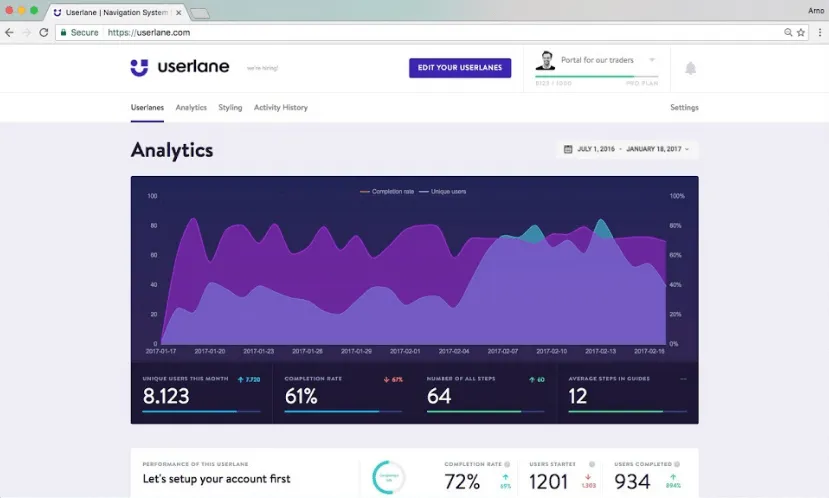
Once learners go through all the guides, contextual help still remains available in the system.
At any point in time, employees can access a virtual assistant that allows them to search for a specific guide.
This is a micro-learning feature embedded in Userlane that enables staff members to quickly access information on demand and be guided through a process they aren’t familiar with anymore in real time.
Userlane was designed to:
- Eliminate the need for conventional and formal software training
- Mitigate the issues linked to the forgetting curve by a) offering a built-in micro-learning tool an b) allowing learners to learn by doing
- Allow employees to be fully proficient from day one on any software application
- Guide users in real time to bypass problems connected to an asynchronous learning experience
- Eliminate the need for re-training when the forgetting curve strikes through or when software goes through major updates
- Create a gamified and pleasant learning experience
- Make users feel as if they were sitting next to a tutor that guides them through processes and helps them make the best decision
- Reduce frustration and allow people to seamlessly operate any software
- Increase software adoption and speed up digitization

Implementing Userlane on a company’s software stack is a smooth and effortless process.
Creating guides require no coding whatsoever thanks to our authoring tool, a super agile editor that allows anybody at your company to quickly create guides for your software by simply clicking through the process that needs to be explained.
We’re very proud of our solution and the fact that hundreds of corporations around the world decided to implement it to onboard and train their employees on their software stack.
That’s why we’d be very happy to provide you with more information about the Userlane learning curve!

